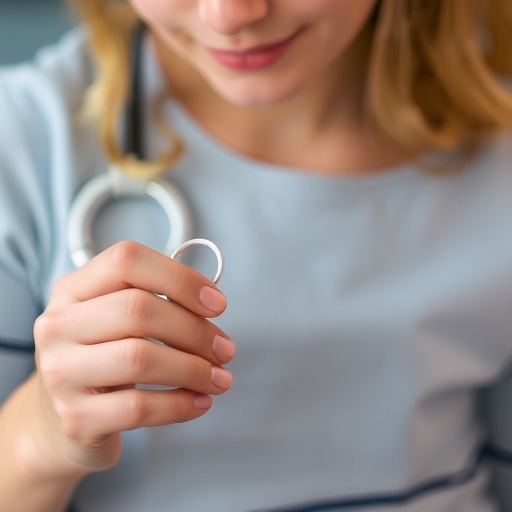Researchers finds first direct link between low-B12 diet, increased risk of infection

Credit: Natasha Kirienko/Rice University
HOUSTON — (March 13, 2019) — Using roundworms, one of Earth’s simplest animals, Rice University bioscientists have found the first direct link between a diet with too little vitamin B12 and an increased risk of infection by two potentially deadly pathogens.
Despite their simplicity, 1-millimeter-long nematodes called Caenorhabditis elegans (C. elegans) share an important limitation with humans: They cannot make B12 and must get all they need from their diet. In a study published today in PLOS Genetics, researchers from the lab of Rice biochemist and cancer researcher Natasha Kirienko describe how a B12-deficient diet harms C. elegans‘ health at a cellular level, reducing the worms’ ability to metabolize branched-chain amino acids (BCAA). The research showed that the reduced ability to break down BCAAs led to a toxic buildup of partially metabolized BCAA byproducts that damaged mitochondrial health.
Researchers studied the health of two populations of worms, one with a diet sufficient in B12 and another that got too little B12 from its diet. Like the second population of worms, at least 10 percent of U.S. adults get too little B12 in their diet, a risk that increases with age.
“We used C. elegans to study the effect of diet on a host and found that one kind of food was able to dramatically increase resistance to multiple stressors — like heat and free radicals — as well as to pathogens,” said Kirienko, assistant professor of biosciences and a CPRIT Scholar in Cancer Research at Rice.
The lead scientist and co-author of the study, Kirienko said the B12 finding came as a surprise to her team, which first noticed the effect in experiments designed to investigate the mechanisms of pathogenesis of Pseudomonas aeruginosa (P. aeruginosa), a potentially deadly disease in both worms and humans that infects some 51,000 U.S. hospital patients each year, according to the Centers for Disease Control.
Her lab, like thousands of others worldwide, uses C. elegans as a model organism to study the effects of disease, drugs, toxins and other processes that affect humans and animals. In many C. elegans research labs worms are fed Escherichia coli (E. coli), a common human gut bacteria that is itself a model organism.
“We found that switching between E. coli strain OP50 and strain HT115 dramatically altered the worm’s stress tolerance,” Kirienko said. She said it took about two years of follow-up studies to isolate the biochemical mechanism of stress and pathogen resistance. Her research team included study lead co-author Alexey Revtovich and co-author Ryan Lee.
“The key difference between the two diets is the ability of HT115 and OP50 to acquire B12 from the environment,” said Revtovich, a research scientist. “We showed that HT115 is far more efficient at this, making about eight times as much of the protein that it needs to harvest B12 as compared to OP50.”
The researchers used numerous tests to confirm their results and rule out other possible mechanisms for the effect. They also found that C. elegans on an HT115 diet had the ability to resist infection by another deadly human pathogen, Enterococcus faecalis.
Lee, a Rice undergraduate student, said the study highlights the need for C. elegans labs worldwide to pay attention to the possible differential impacts of diet on experimental outcomes.
“Some labs use OP50 as their standard food, and others use HT115 or even another strain of E. coli,” Lee said. “Our results show there are significant metabolic differences between these diets, and it’s likely those differences could contribute to substantial uncertainty in research outcomes.”
Kirienko joined Rice’s faculty in 2015 thanks to a recruitment grant from the Cancer Prevention and Research Institute of Texas (CPRIT), a state ballot initiative approved in 2007 to provide $3 billion to support cancer research statewide. To date, CPRIT has awarded $2.2 billion in grants to Texas researchers, institutions and organizations through its academic research, prevention and product development research programs.
“This work is related in the sense that it focuses on mitochondrial health,” Kirienko said. “In this case, we are working to improve mitochondrial health to help fight infections. For CPRIT, we’re trying to do the opposite. We want to damage mitochondria in cancer cells to kill them. So, actually, now that we know this is important, it gives us another potential target in cancer cells.”
###
The research was funded by the National Institutes of Health, CPRIT and the Welch Foundation.
EDITORS — High-resolution images are linked at the end of the news release.
MEDIA CONTACTS:
David Ruth 713-348-6327 [email protected]
Jade Boyd 713-348-6778 [email protected]
High-resolution IMAGES are available for download at:
https:/
CAPTION: Rice University researchers (from left) Ryan Lee, Alexey Revtovich and Natasha Kirienko showed how a dietary deficit of vitamin B12 harms the health of nematodes at a cellular level, leading to an increased risk of infection by two potentially deadly pathogens. (Photo by Jeff Fitlow/Rice University)
https:/
CAPTION:
Alexey Revtovich (Photo by Jeff Fitlow/Rice University)
https:/
CAPTION:
Ryan Lee (Photo by Jeff Fitlow/Rice University)
https:/
The DOI of the PLOS Genetics paper is: 10.1371/journal.pgen.1008011
A copy of the paper is available at: https:/
Related research from Rice:
Mitochondrial mechanisms focus of study — Sept. 27, 2018?http://news.
Research initiatives score Dunn Awards — Nov. 14, 2018?http://news.
Rice recruits cancer researcher from Harvard with CPRIT grant — May 26, 2015?http://news.
This release can be found online at https:/
Follow Rice News and Media Relations via Twitter @RiceUNews.
Located on a 300-acre forested campus in Houston, Rice University is consistently ranked among the nation’s top 20 universities by U.S. News & World Report. Rice has highly respected schools of Architecture, Business, Continuing Studies, Engineering, Humanities, Music, Natural Sciences and Social Sciences and is home to the Baker Institute for Public Policy. With 3,962 undergraduates and 3,027 graduate students, Rice’s undergraduate student-to-faculty ratio is just under 6-to-1. Its residential college system builds close-knit communities and lifelong friendships, just one reason why Rice is ranked No. 1 for lots of race/class interaction and No. 2 for quality of life by the Princeton Review. Rice is also rated as a best value among private universities by Kiplinger’s Personal Finance.
If you do not wish to receive news releases from Rice University, reply to this email and write “unsubscribe” in the subject line.
Media Contact
David Ruth
[email protected]
Related Journal Article
http://dx.




